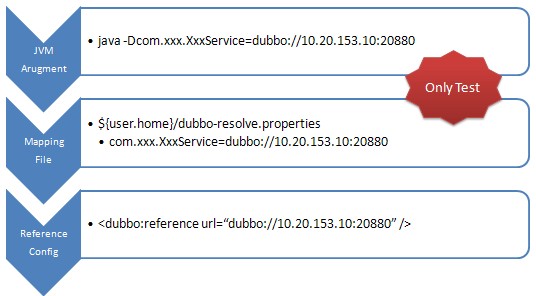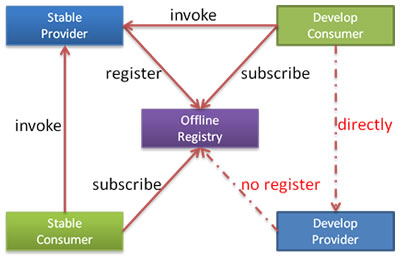dubbo示例(上)
来源:互联网 发布:权力的游戏小玫瑰知乎 编辑:程序博客网 时间:2024/06/06 01:14
http://alibaba.github.io/dubbo-doc-static/Examples-zh.htm
示例
(+) (#)
启动时检查
(+) (#)
可以通过check="false"关闭检查,比如,测试时,有些服务不关心,或者出现了循环依赖,必须有一方先启动。
关闭某个服务的启动时检查:(没有提供者时报错)
<dubbo:referenceinterface="com.foo.BarService"check="false"/>关闭所有服务的启动时检查:(没有提供者时报错)
<dubbo:consumercheck="false"/>关闭注册中心启动时检查:(注册订阅失败时报错)
<dubbo:registrycheck="false"/>也可以用dubbo.properties配置:
dubbo.reference.com.foo.BarService.check=falsedubbo.reference.check=falsedubbo.consumer.check=falsedubbo.registry.check=false也可以用-D参数:
java -Ddubbo.reference.com.foo.BarService.check=falsejava -Ddubbo.reference.check=falsejava -Ddubbo.consumer.check=false java -Ddubbo.registry.check=false引用缺省是延迟初始化的,只有引用被注入到其它Bean,或被getBean()获取,才会初始化。
如果需要饥饿加载,即没有人引用也立即生成动态代理,可以配置:
<dubbo:referenceinterface="com.foo.BarService"init="true"/>集群容错
(+) (#)

各节点关系:
- 这里的Invoker是Provider的一个可调用Service的抽象,Invoker封装了Provider地址及Service接口信息。
- Directory代表多个Invoker,可以把它看成List<Invoker>,但与List不同的是,它的值可能是动态变化的,比如注册中心推送变更。
- Cluster将Directory中的多个Invoker伪装成一个Invoker,对上层透明,伪装过程包含了容错逻辑,调用失败后,重试另一个。
- Router负责从多个Invoker中按路由规则选出子集,比如读写分离,应用隔离等。
- LoadBalance负责从多个Invoker中选出具体的一个用于本次调用,选的过程包含了负载均衡算法,调用失败后,需要重选。
集群容错模式:
可以自行扩展集群容错策略,参见:集群扩展
Failover Cluster
- 失败自动切换,当出现失败,重试其它服务器。(缺省)
- 通常用于读操作,但重试会带来更长延迟。
- 可通过retries="2"来设置重试次数(不含第一次)。
Failfast Cluster
- 快速失败,只发起一次调用,失败立即报错。
- 通常用于非幂等性的写操作,比如新增记录。
Failsafe Cluster
- 失败安全,出现异常时,直接忽略。
- 通常用于写入审计日志等操作。
Failback Cluster
- 失败自动恢复,后台记录失败请求,定时重发。
- 通常用于消息通知操作。
Forking Cluster
- 并行调用多个服务器,只要一个成功即返回。
- 通常用于实时性要求较高的读操作,但需要浪费更多服务资源。
- 可通过forks="2"来设置最大并行数。
Broadcast Cluster
- 广播调用所有提供者,逐个调用,任意一台报错则报错。(2.1.0开始支持)
- 通常用于通知所有提供者更新缓存或日志等本地资源信息。
重试次数配置如:(failover集群模式生效)
<dubbo:serviceretries="2"/>或:
<dubbo:referenceretries="2"/>或:
<dubbo:reference> <dubbo:methodname="findFoo"retries="2"/></dubbo:reference>集群模式配置如:
<dubbo:servicecluster="failsafe"/>或:
<dubbo:referencecluster="failsafe"/>负载均衡
(+) (#)
可以自行扩展负载均衡策略,参见:负载均衡扩展
Random LoadBalance
- 随机,按权重设置随机概率。
- 在一个截面上碰撞的概率高,但调用量越大分布越均匀,而且按概率使用权重后也比较均匀,有利于动态调整提供者权重。
RoundRobin LoadBalance
- 轮循,按公约后的权重设置轮循比率。
- 存在慢的提供者累积请求问题,比如:第二台机器很慢,但没挂,当请求调到第二台时就卡在那,久而久之,所有请求都卡在调到第二台上。
LeastActive LoadBalance
- 最少活跃调用数,相同活跃数的随机,活跃数指调用前后计数差。
- 使慢的提供者收到更少请求,因为越慢的提供者的调用前后计数差会越大。
ConsistentHash LoadBalance
- 一致性Hash,相同参数的请求总是发到同一提供者。
- 当某一台提供者挂时,原本发往该提供者的请求,基于虚拟节点,平摊到其它提供者,不会引起剧烈变动。
- 算法参见:http://en.wikipedia.org/wiki/Consistent_hashing。
- 缺省只对第一个参数Hash,如果要修改,请配置<dubbo:parameter key="hash.arguments" value="0,1" />
- 缺省用160份虚拟节点,如果要修改,请配置<dubbo:parameter key="hash.nodes" value="320" />
配置如:
<dubbo:serviceinterface="..."loadbalance="roundrobin"/>或:
<dubbo:referenceinterface="..."loadbalance="roundrobin"/>或:
<dubbo:serviceinterface="..."> <dubbo:methodname="..."loadbalance="roundrobin"/></dubbo:service>或:
<dubbo:referenceinterface="..."> <dubbo:methodname="..."loadbalance="roundrobin"/></dubbo:reference>线程模型
(+) (#)

- Dispatcher
- all 所有消息都派发到线程池,包括请求,响应,连接事件,断开事件,心跳等。
- direct 所有消息都不派发到线程池,全部在IO线程上直接执行。
- message 只有请求响应消息派发到线程池,其它连接断开事件,心跳等消息,直接在IO线程上执行。
- execution 只请求消息派发到线程池,不含响应,响应和其它连接断开事件,心跳等消息,直接在IO线程上执行。
- connection 在IO线程上,将连接断开事件放入队列,有序逐个执行,其它消息派发到线程池。
- ThreadPool
- fixed 固定大小线程池,启动时建立线程,不关闭,一直持有。(缺省)
- cached 缓存线程池,空闲一分钟自动删除,需要时重建。
- limited 可伸缩线程池,但池中的线程数只会增长不会收缩。(为避免收缩时突然来了大流量引起的性能问题)。
配置如:
<dubbo:protocolname="dubbo"dispatcher="all"threadpool="fixed"threads="100"/>直连提供者
(+) (#)
在开发及测试环境下,经常需要绕过注册中心,只测试指定服务提供者,这时候可能需要点对点直连,
点对点直联方式,将以服务接口为单位,忽略注册中心的提供者列表,
A接口配置点对点,不影响B接口从注册中心获取列表。

(1) 如果是线上需求需要点对点,可在<dubbo:reference>中配置url指向提供者,将绕过注册中心,多个地址用分号隔开,配置如下:(1.0.6及以上版本支持)
<dubbo:reference id="xxxService"interface="com.alibaba.xxx.XxxService"url="dubbo://localhost:20890"/>(2) 在JVM启动参数中加入-D参数映射服务地址,如:
(key为服务名,value为服务提供者url,此配置优先级最高,1.0.15及以上版本支持)
java -Dcom.alibaba.xxx.XxxService=dubbo://localhost:20890(3) 如果服务比较多,也可以用文件映射,如:
(用-Ddubbo.resolve.file指定映射文件路径,此配置优先级高于<dubbo:reference>中的配置,1.0.15及以上版本支持)
(2.0以上版本自动加载${user.home}/dubbo-resolve.properties文件,不需要配置)
java -Ddubbo.resolve.file=xxx.properties然后在映射文件xxx.properties中加入:
(key为服务名,value为服务提供者url)
com.alibaba.xxx.XxxService=dubbo://localhost:20890只订阅
(+) (#)

禁用注册配置:
<dubbo:registryaddress="10.20.153.10:9090"register="false"/>或者:
<dubbo:registryaddress="10.20.153.10:9090?register=false"/>只注册
(+) (#)
禁用订阅配置:
<dubbo:registryid="hzRegistry"address="10.20.153.10:9090"/><dubbo:registryid="qdRegistry"address="10.20.141.150:9090"subscribe="false"/>或者:
<dubbo:registryid="hzRegistry"address="10.20.153.10:9090"/><dubbo:registryid="qdRegistry"address="10.20.141.150:9090?subscribe=false"/>静态服务
(+) (#)
<dubbo:registryaddress="10.20.141.150:9090"dynamic="false"/>或者:
<dubbo:registryaddress="10.20.141.150:9090?dynamic=false"/>服务提供者初次注册时为禁用状态,需人工启用,断线时,将不会被自动删除,需人工禁用。
如果是一个第三方独立提供者,比如memcached等,可以直接向注册中心写入提供者地址信息,消费者正常使用:
(通常由脚本监控中心页面等调用)
RegistryFactory registryFactory = ExtensionLoader.getExtensionLoader(RegistryFactory.class).getAdaptiveExtension();Registry registry = registryFactory.getRegistry(URL.valueOf("zookeeper://10.20.153.10:2181"));registry.register(URL.valueOf("memcached://10.20.153.11/com.foo.BarService?category=providers&dynamic=false&application=foo"));多协议
(+) (#)
可以自行扩展协议,参见:协议扩展
(1) 不同服务不同协议
比如:不同服务在性能上适用不同协议进行传输,比如大数据用短连接协议,小数据大并发用长连接协议。
consumer.xml
<?xml version="1.0" encoding="UTF-8"?><beans xmlns="http://www.springframework.org/schema/beans" xmlns:xsi="http://www.w3.org/2001/XMLSchema-instance" xmlns:dubbo="http://code.alibabatech.com/schema/dubbo" xsi:schemaLocation="http://www.springframework.org/schema/beanshttp://www.springframework.org/schema/beans/spring-beans.xsdhttp://code.alibabatech.com/schema/dubbohttp://code.alibabatech.com/schema/dubbo/dubbo.xsd"> <dubbo:application name="world" /> <dubbo:registry id="registry" address="10.20.141.150:9090" username="admin" password="hello1234" /> <!-- 多协议配置 --> <dubbo:protocol name="dubbo" port="20880" /> <dubbo:protocol name="rmi" port="1099" /> <!-- 使用dubbo协议暴露服务 --> <dubbo:service interface="com.alibaba.hello.api.HelloService" version="1.0.0" ref="helloService" protocol="dubbo" /> <!-- 使用rmi协议暴露服务 --> <dubbo:service interface="com.alibaba.hello.api.DemoService" version="1.0.0" ref="demoService" protocol="rmi" /> </beans>
(2) 多协议暴露服务
比如:需要与http客户端互操作
consumer.xml
<?xml version="1.0" encoding="UTF-8"?><beans xmlns="http://www.springframework.org/schema/beans" xmlns:xsi="http://www.w3.org/2001/XMLSchema-instance" xmlns:dubbo="http://code.alibabatech.com/schema/dubbo" xsi:schemaLocation="http://www.springframework.org/schema/beanshttp://www.springframework.org/schema/beans/spring-beans.xsdhttp://code.alibabatech.com/schema/dubbohttp://code.alibabatech.com/schema/dubbo/dubbo.xsd"> <dubbo:application name="world" /> <dubbo:registry id="registry" address="10.20.141.150:9090" username="admin" password="hello1234" /> <!-- 多协议配置 --> <dubbo:protocol name="dubbo" port="20880" /> <dubbo:protocol name="hessian" port="8080" /> <!-- 使用多个协议暴露服务 --> <dubbo:service id="helloService" interface="com.alibaba.hello.api.HelloService" version="1.0.0" protocol="dubbo,hessian" /> </beans>
多注册中心
(+) (#)
可以自行扩展注册中心,参见:注册中心扩展
(1) 多注册中心注册
比如:中文站有些服务来不及在青岛部署,只在杭州部署,而青岛的其它应用需要引用此服务,就可以将服务同时注册到两个注册中心。
consumer.xml
<?xml version="1.0" encoding="UTF-8"?><beans xmlns="http://www.springframework.org/schema/beans" xmlns:xsi="http://www.w3.org/2001/XMLSchema-instance" xmlns:dubbo="http://code.alibabatech.com/schema/dubbo" xsi:schemaLocation="http://www.springframework.org/schema/beanshttp://www.springframework.org/schema/beans/spring-beans.xsdhttp://code.alibabatech.com/schema/dubbohttp://code.alibabatech.com/schema/dubbo/dubbo.xsd"> <dubbo:application name="world" /> <!-- 多注册中心配置 --> <dubbo:registry id="hangzhouRegistry" address="10.20.141.150:9090" /> <dubbo:registry id="qingdaoRegistry" address="10.20.141.151:9010" default="false" /> <!-- 向多个注册中心注册 --> <dubbo:service interface="com.alibaba.hello.api.HelloService" version="1.0.0" ref="helloService" registry="hangzhouRegistry,qingdaoRegistry" /> </beans>
(2) 不同服务使用不同注册中心
比如:CRM有些服务是专门为国际站设计的,有些服务是专门为中文站设计的。
consumer.xml
<?xml version="1.0" encoding="UTF-8"?><beans xmlns="http://www.springframework.org/schema/beans" xmlns:xsi="http://www.w3.org/2001/XMLSchema-instance" xmlns:dubbo="http://code.alibabatech.com/schema/dubbo" xsi:schemaLocation="http://www.springframework.org/schema/beanshttp://www.springframework.org/schema/beans/spring-beans.xsdhttp://code.alibabatech.com/schema/dubbohttp://code.alibabatech.com/schema/dubbo/dubbo.xsd"> <dubbo:application name="world" /> <!-- 多注册中心配置 --> <dubbo:registry id="chinaRegistry" address="10.20.141.150:9090" /> <dubbo:registry id="intlRegistry" address="10.20.154.177:9010" default="false" /> <!-- 向中文站注册中心注册 --> <dubbo:service interface="com.alibaba.hello.api.HelloService" version="1.0.0" ref="helloService" registry="chinaRegistry" /> <!-- 向国际站注册中心注册 --> <dubbo:service interface="com.alibaba.hello.api.DemoService" version="1.0.0" ref="demoService" registry="intlRegistry" /> </beans>
(3) 多注册中心引用
比如:CRM需同时调用中文站和国际站的PC2服务,PC2在中文站和国际站均有部署,接口及版本号都一样,但连的数据库不一样。
consumer.xml
<?xml version="1.0" encoding="UTF-8"?><beans xmlns="http://www.springframework.org/schema/beans" xmlns:xsi="http://www.w3.org/2001/XMLSchema-instance" xmlns:dubbo="http://code.alibabatech.com/schema/dubbo" xsi:schemaLocation="http://www.springframework.org/schema/beanshttp://www.springframework.org/schema/beans/spring-beans.xsdhttp://code.alibabatech.com/schema/dubbohttp://code.alibabatech.com/schema/dubbo/dubbo.xsd"> <dubbo:application name="world" /> <!-- 多注册中心配置 --> <dubbo:registry id="chinaRegistry" address="10.20.141.150:9090" /> <dubbo:registry id="intlRegistry" address="10.20.154.177:9010" default="false" /> <!-- 引用中文站服务 --> <dubbo:reference id="chinaHelloService" interface="com.alibaba.hello.api.HelloService" version="1.0.0" registry="chinaRegistry" /> <!-- 引用国际站站服务 --> <dubbo:reference id="intlHelloService" interface="com.alibaba.hello.api.HelloService" version="1.0.0" registry="intlRegistry" /> </beans>
如果只是测试环境临时需要连接两个不同注册中心,使用竖号分隔多个不同注册中心地址:
consumer.xml
<span style="font-size:14px;"><?xml version="1.0" encoding="UTF-8"?><beans xmlns="http://www.springframework.org/schema/beans" xmlns:xsi="http://www.w3.org/2001/XMLSchema-instance" xmlns:dubbo="http://code.alibabatech.com/schema/dubbo" xsi:schemaLocation="http://www.springframework.org/schema/beanshttp://www.springframework.org/schema/beans/spring-beans.xsdhttp://code.alibabatech.com/schema/dubbohttp://code.alibabatech.com/schema/dubbo/dubbo.xsd"> <dubbo:application name="world" /> <!-- 多注册中心配置,竖号分隔表示同时连接多个不同注册中心,同一注册中心的多个集群地址用逗号分隔 --> <dubbo:registry address="10.20.141.150:9090|10.20.154.177:9010" /> <!-- 引用服务 --> <dubbo:reference id="helloService" interface="com.alibaba.hello.api.HelloService" version="1.0.0" /> </beans></span>
服务分组
(+) (#)
<dubbo:servicegroup="feedback"interface="com.xxx.IndexService"/><dubbo:servicegroup="member"interface="com.xxx.IndexService"/><dubbo:referenceid="feedbackIndexService"group="feedback"interface="com.xxx.IndexService"/><dubbo:referenceid="memberIndexService"group="member"interface="com.xxx.IndexService"/>任意组:(2.2.0以上版本支持,总是只调一个可用组的实现)
<dubbo:referenceid="barService"interface="com.foo.BarService"group="*"/>多版本
(+) (#)
- 在低压力时间段,先升级一半提供者为新版本
- 再将所有消费者升级为新版本
- 然后将剩下的一半提供者升级为新版本
<dubbo:serviceinterface="com.foo.BarService"version="1.0.0"/><dubbo:serviceinterface="com.foo.BarService"version="2.0.0"/><dubbo:referenceid="barService"interface="com.foo.BarService"version="1.0.0"/><dubbo:referenceid="barService"interface="com.foo.BarService"version="2.0.0"/>不区分版本:(2.2.0以上版本支持)
<dubbo:referenceid="barService"interface="com.foo.BarService"version="*"/>分组聚合
(+) (#)

代码参见:https://github.com/alibaba/dubbo/tree/master/dubbo-test/dubbo-test-examples/src/main/java/com/alibaba/dubbo/examples/merge
配置如:(搜索所有分组)
<dubbo:referenceinterface="com.xxx.MenuService"group="*"merger="true"/>或:(合并指定分组)
<dubbo:referenceinterface="com.xxx.MenuService"group="aaa,bbb"merger="true"/>或:(指定方法合并结果,其它未指定的方法,将只调用一个Group)
<dubbo:referenceinterface="com.xxx.MenuService"group="*"> <dubbo:methodname="getMenuItems"merger="true"/></dubbo:service>或:(某个方法不合并结果,其它都合并结果)
<dubbo:referenceinterface="com.xxx.MenuService"group="*"merger="true"> <dubbo:methodname="getMenuItems"merger="false"/></dubbo:service>或:(指定合并策略,缺省根据返回值类型自动匹配,如果同一类型有两个合并器时,需指定合并器的名称)
参见:[合并结果扩展]
<dubbo:referenceinterface="com.xxx.MenuService"group="*"> <dubbo:methodname="getMenuItems"merger="mymerge"/></dubbo:service>或:(指定合并方法,将调用返回结果的指定方法进行合并,合并方法的参数类型必须是返回结果类型本身)
<dubbo:referenceinterface="com.xxx.MenuService"group="*"> <dubbo:methodname="getMenuItems"merger=".addAll"/></dubbo:service>参数验证
(+) (#)
完整示例代码参见:https://github.com/alibaba/dubbo/tree/master/dubbo-test/dubbo-test-examples/src/main/java/com/alibaba/dubbo/examples/validation
验证方式可扩展,参见:Validation扩展点
参数标注示例:
importjava.io.Serializable;importjava.util.Date;importjavax.validation.constraints.Future;importjavax.validation.constraints.Max;importjavax.validation.constraints.Min;importjavax.validation.constraints.NotNull;importjavax.validation.constraints.Past;importjavax.validation.constraints.Pattern;importjavax.validation.constraints.Size;publicclassValidationParameter implementsSerializable { privatestaticfinal long serialVersionUID = 7158911668568000392L; @NotNull// 不允许为空 @Size(min = 1, max = 20)// 长度或大小范围 privateString name; @NotNull(groups = ValidationService.Save.class)// 保存时不允许为空,更新时允许为空 ,表示不更新该字段 @Pattern(regexp = "^\\s*\\w+(?:\\.{0,1}[\\w-]+)*@[a-zA-Z0-9]+(?:[-.][a-zA-Z0-9]+)*\\.[a-zA-Z]+\\s*$") privateString email; @Min(18)// 最小值 @Max(100)// 最大值 privateintage; @Past// 必须为一个过去的时间 privateDate loginDate; @Future// 必须为一个未来的时间 privateDate expiryDate; publicString getName() { returnname; } publicvoidsetName(String name) { this.name = name; } publicString getEmail() { returnemail; } publicvoidsetEmail(String email) { this.email = email; } publicintgetAge() { returnage; } publicvoidsetAge(intage) { this.age = age; } publicDate getLoginDate() { returnloginDate; } publicvoidsetLoginDate(Date loginDate) { this.loginDate = loginDate; } publicDate getExpiryDate() { returnexpiryDate; } publicvoidsetExpiryDate(Date expiryDate) { this.expiryDate = expiryDate; }}分组验证示例:
publicinterfaceValidationService { // 缺省可按服务接口区分验证场景,如:@NotNull(groups = ValidationService.class) @interfaceSave{}// 与方法同名接口,首字母大写,用于区分验证场景,如:@NotNull(groups = ValidationService.Save.class),可选 voidsave(ValidationParameter parameter); voidupdate(ValidationParameter parameter);}关联验证示例:
importjavax.validation.GroupSequence;publicinterfaceValidationService { @GroupSequence(Update.class)// 同时验证Update组规则 @interfaceSave{} voidsave(ValidationParameter parameter); @interfaceUpdate{} voidupdate(ValidationParameter parameter);}参数验证示例:
importjavax.validation.constraints.Min;importjavax.validation.constraints.NotNull;publicinterfaceValidationService { voidsave(@NotNullValidationParameter parameter); // 验证参数不为空 voiddelete(@Min(1)intid);// 直接对基本类型参数验证}在客户端验证参数:
<dubbo:referenceid="validationService"interface="com.alibaba.dubbo.examples.validation.api.ValidationService"validation="true"/>在服务器端验证参数:
<dubbo:serviceinterface="com.alibaba.dubbo.examples.validation.api.ValidationService"ref="validationService"validation="true"/>验证异常信息:
importjavax.validation.ConstraintViolationException;importjavax.validation.ConstraintViolationException;importorg.springframework.context.support.ClassPathXmlApplicationContext;importcom.alibaba.dubbo.examples.validation.api.ValidationParameter;importcom.alibaba.dubbo.examples.validation.api.ValidationService;importcom.alibaba.dubbo.rpc.RpcException;publicclassValidationConsumer { publicstaticvoid main(String[] args) throwsException { String config = ValidationConsumer.class.getPackage().getName().replace('.','/') + "/validation-consumer.xml"; ClassPathXmlApplicationContext context = newClassPathXmlApplicationContext(config); context.start(); ValidationService validationService = (ValidationService)context.getBean("validationService"); // Error try{ parameter = newValidationParameter(); validationService.save(parameter); System.out.println("Validation ERROR"); }catch(RpcException e) { // 抛出的是RpcException ConstraintViolationException ve = (ConstraintViolationException) e.getCause(); // 里面嵌了一个ConstraintViolationException Set<ConstraintViolation<?>> violations = ve.getConstraintViolations(); // 可以拿到一个验证错误详细信息的集合 System.out.println(violations); } }}需要加入依赖:
<dependency> <groupId>javax.validation</groupId> <artifactId>validation-api</artifactId> <version>1.0.0.GA</version></dependency><dependency> <groupId>org.hibernate</groupId> <artifactId>hibernate-validator</artifactId> <version>4.2.0.Final</version></dependency>结果缓存
(+) (#)
示例代码:https://github.com/alibaba/dubbo/tree/master/dubbo-test/dubbo-test-examples/src/main/java/com/alibaba/dubbo/examples/cache
- lru 基于最近最少使用原则删除多余缓存,保持最热的数据被缓存。
- threadlocal 当前线程缓存,比如一个页面渲染,用到很多portal,每个portal都要去查用户信息,通过线程缓存,可以减少这种多余访问。
- jcache 与JSR107集成,可以桥接各种缓存实现。
缓存类型可扩展,参见:CacheFactory扩展点
配置如:
<dubbo:referenceinterface="com.foo.BarService"cache="lru"/>或:
<dubbo:referenceinterface="com.foo.BarService"> <dubbo:methodname="findBar"cache="lru"/></dubbo:reference>泛化引用
(+) (#)
<dubbo:referenceid="barService"interface="com.foo.BarService"generic="true"/>GenericService barService = (GenericService) applicationContext.getBean("barService");Object result = barService.$invoke("sayHello",newString[] { "java.lang.String"},newObject[] { "World"});importcom.alibaba.dubbo.rpc.service.GenericService;...// 引用远程服务 ReferenceConfig<GenericService> reference = newReferenceConfig<GenericService>();// 该实例很重量,里面封装了所有与注册中心及服务提供方连接,请缓存reference.setInterface("com.xxx.XxxService");// 弱类型接口名 reference.setVersion("1.0.0");reference.setGeneric(true);// 声明为泛化接口 GenericService genericService = reference.get(); // 用com.alibaba.dubbo.rpc.service.GenericService可以替代所有接口引用 // 基本类型以及Date,List,Map等不需要转换,直接调用 Object result = genericService.$invoke("sayHello",newString[] {"java.lang.String"},newObject[] {"world"});// 用Map表示POJO参数,如果返回值为POJO也将自动转成Map Map<String, Object> person = newHashMap<String, Object>(); person.put("name","xxx");person.put("password","yyy");Object result = genericService.$invoke("findPerson",newString[]{"com.xxx.Person"},newObject[]{person});// 如果返回POJO将自动转成Map ...假设存在POJO如:
packagecom.xxx;publicclassPersonImpl implementsPerson { privateString name; privateString password; publicString getName() { returnname;}publicvoidsetName(String name) { this.name = name; }publicString getPassword() { returnpassword;}publicvoidsetPassword(String password) { this.password= password; }}则POJO数据:
Person person = newPersonImpl();person.setName("xxx");person.setPassword("yyy");可用下面Map表示:
Map<String, Object> map = newHashMap<String, Object>(); map.put("class","com.xxx.PersonImpl");// 注意:如果参数类型是接口,或者List等丢失泛型,可通过class属性指定类型。map.put("name","xxx");map.put("password","yyy");泛化实现
(+) (#)
<beanid="genericService"class="com.foo.MyGenericService"/><dubbo:serviceinterface="com.foo.BarService"ref="genericService"/>packagecom.foo;publicclassMyGenericService implementsGenericService { publicObject $invoke(String methodName, String[] parameterTypes, Object[] args) throwsGenericException { if("sayHello".equals(methodName)) { return"Welcome " + args[0]; } }}...GenericService xxxService = newXxxGenericService();// 用com.alibaba.dubbo.rpc.service.GenericService可以替代所有接口实现 ServiceConfig<GenericService> service = newServiceConfig<GenericService>();// 该实例很重量,里面封装了所有与注册中心及服务提供方连接,请缓存service.setInterface("com.xxx.XxxService");// 弱类型接口名 service.setVersion("1.0.0");service.setRef(xxxService);// 指向一个通用服务实现 // 暴露及注册服务 service.export();回声测试
(+) (#)
<dubbo:referenceid="memberService"interface="com.xxx.MemberService"/>MemberService memberService = ctx.getBean("memberService");// 远程服务引用EchoService echoService = (EchoService) memberService; // 强制转型为EchoServiceString status = echoService.$echo("OK");// 回声测试可用性assert(status.equals("OK"))上下文信息
(+) (#)
(1) 服务消费方
xxxService.xxx();// 远程调用booleanisConsumerSide = RpcContext.getContext().isConsumerSide(); // 本端是否为消费端,这里会返回trueString serverIP = RpcContext.getContext().getRemoteHost(); // 获取最后一次调用的提供方IP地址String application = RpcContext.getContext().getUrl().getParameter("application");// 获取当前服务配置信息,所有配置信息都将转换为URL的参数// ...yyyService.yyy();// 注意:每发起RPC调用,上下文状态会变化// ...(2) 服务提供方
publicclassXxxServiceImpl implementsXxxService { publicvoidxxx() { // 服务方法实现 booleanisProviderSide = RpcContext.getContext().isProviderSide(); // 本端是否为提供端,这里会返回true String clientIP = RpcContext.getContext().getRemoteHost(); // 获取调用方IP地址 String application = RpcContext.getContext().getUrl().getParameter("application");// 获取当前服务配置信息,所有配置信息都将转换为URL的参数 // ... yyyService.yyy();// 注意:每发起RPC调用,上下文状态会变化 booleanisProviderSide = RpcContext.getContext().isProviderSide(); // 此时本端变成消费端,这里会返回false // ... }}隐式传参
(+) (#)

(1) 服务消费方
RpcContext.getContext().setAttachment("index","1");// 隐式传参,后面的远程调用都会隐式将这些参数发送到服务器端,类似cookie,用于框架集成,不建议常规业务使用xxxService.xxx();// 远程调用// ...【注】 setAttachment设置的KV,在完成下面一次远程调用会被清空。即多次远程调用要多次设置。
(2) 服务提供方
publicclassXxxServiceImpl implementsXxxService { publicvoidxxx() { // 服务方法实现 String index = RpcContext.getContext().getAttachment("index");// 获取客户端隐式传入的参数,用于框架集成,不建议常规业务使用 // ... }}异步调用
(+) (#)

配置声明:
<dubbo:referenceid="fooService"interface="com.alibaba.foo.FooService"> <dubbo:methodname="findFoo"async="true"/></dubbo:reference><dubbo:referenceid="barService"interface="com.alibaba.bar.BarService"> <dubbo:methodname="findBar"async="true"/></dubbo:reference>调用代码:
fooService.findFoo(fooId);// 此调用会立即返回nullFuture<Foo> fooFuture = RpcContext.getContext().getFuture(); // 拿到调用的Future引用,当结果返回后,会被通知和设置到此Future。barService.findBar(barId);// 此调用会立即返回nullFuture<Bar> barFuture = RpcContext.getContext().getFuture(); // 拿到调用的Future引用,当结果返回后,会被通知和设置到此Future。// 此时findFoo和findBar的请求同时在执行,客户端不需要启动多线程来支持并行,而是借助NIO的非阻塞完成。Foo foo = fooFuture.get(); // 如果foo已返回,直接拿到返回值,否则线程wait住,等待foo返回后,线程会被notify唤醒。Bar bar = barFuture.get(); // 同理等待bar返回。// 如果foo需要5秒返回,bar需要6秒返回,实际只需等6秒,即可获取到foo和bar,进行接下来的处理。你也可以设置是否等待消息发出:(异步总是不等待返回)
- sent="true" 等待消息发出,消息发送失败将抛出异常。
- sent="false" 不等待消息发出,将消息放入IO队列,即刻返回。
<dubbo:methodname="findFoo"async="true"sent="true"/>
如果你只是想异步,完全忽略返回值,可以配置return="false",以减少Future对象的创建和管理成本:
<dubbo:methodname="findFoo"async="true"return="false"/>本地调用
- dubbo示例(上)
- dubbo示例(下)
- dubbo配置方式(上)
- Dubbo入门示例
- Dubbo集群示例
- Dubbo入门简单示例
- dubbo zookeeper 入门示例
- dubbo入门示例
- Dubbo-概述,示例Demo
- dubbo+zookeeper示例
- dubbo入门示例
- 初识Dubbo 系列之7-Dubbo 示例
- Dubbo入门学习--Dubbo简单示例
- Dubbo之旅--Provider示例
- Dubbo之旅--Consumer示例
- Dubbo spring mvc整合示例
- Dubbo之旅--Provider示例
- Dubbo之旅--Consumer示例
- 本人介绍
- 手机多媒体--调用摄像头
- React Native常用组件Image使用
- 中小企业监控体系构建实战--案例分享(内附传送门)
- 【C++心路历程14】1177状态数组 查找(比binary好用多了)
- dubbo示例(上)
- orcal 导入导出
- Leetcode题解:419. Battleships in a Board
- 我的跨专业程序猿之路
- ssh无法root,但能普通用户
- 学习TQ210 开发板心得
- Abot 爬虫
- Android知识点备份
- SharePoint Framework 把你的客户端web部件部署到经典的SharePoint页面


